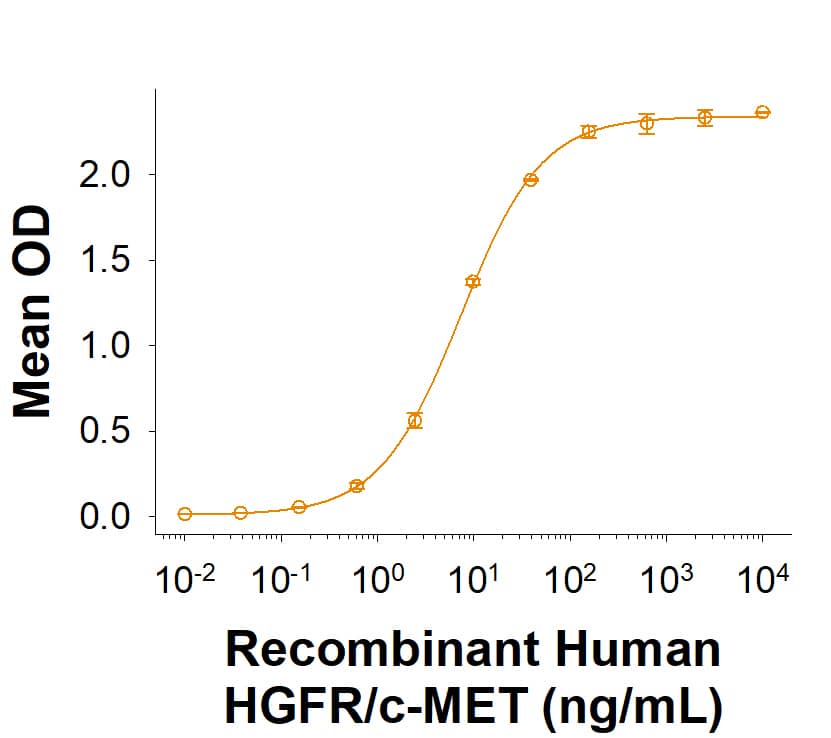Recombinant Human HGF (NS0-expressed) Biotin Protein, CF
R&D Systems, part of Bio-Techne | Catalog # BT294
Biotinylated

Key Product Details
- R&D Systems NS0-derived Recombinant Human HGF (NS0-expressed) Biotin Protein (BT294)
- Quality control testing to verify active proteins with lot specific assays by in-house scientists
- All R&D Systems proteins are covered with a 100% guarantee
Source
NS0
Accession #
Structure / Form
Disulfide-linked
heterodimer
Biotinylated via amines
Biotinylated via amines
Conjugate
Biotin
Applications
Bioactivity
Product Specifications
Source
Mouse myeloma cell line, NS0-derived human HGF protein
Gln32-Ser728 (Asp384Asn, Asp416Asn, Leu622Ser, His645Arg, Val678Ile)
Gln32-Ser728 (Asp384Asn, Asp416Asn, Leu622Ser, His645Arg, Val678Ile)
Purity
>95%, by SDS-PAGE visualized with Silver Staining and quantitative densitometry by Coomassie® Blue Staining.
Endotoxin Level
<0.10 EU per 1 μg of the protein by the LAL method.
N-terminal Sequence Analysis
alpha chain: No results obtained; Gln32 predicted
beta
chain: Val495
Predicted Molecular Mass
alpha chain: 53.7 kDa
beta chain: 26 kDa
SDS-PAGE
55-69 kDa and 24-39 kDa, under reducing conditions.
Activity
Measured by its binding ability in a functional ELISA.
When Biotinylated Recombinant Human HGF Prorein (Catalog # BT294) is captured on EvenCoat Streptavidin Coated Plates (Catalog # CP004) at 0.500 μg/mL (100 μL/well), Recombinant Human HGFR/c-MET Fc Chimera Protein (Catalog # 8614-MT) binds with an ED50 of 6.00-60.0 ng/mL.
When Biotinylated Recombinant Human HGF Prorein (Catalog # BT294) is captured on EvenCoat Streptavidin Coated Plates (Catalog # CP004) at 0.500 μg/mL (100 μL/well), Recombinant Human HGFR/c-MET Fc Chimera Protein (Catalog # 8614-MT) binds with an ED50 of 6.00-60.0 ng/mL.
Reviewed Applications
Read 1 review rated 5 using BT294 in the following applications:
Scientific Data Images for Recombinant Human HGF (NS0-expressed) Biotin Protein, CF
Biotinylated Recombinant Human HGF Protein Binding Activity.
Measured by its binding ability in a functional ELISA. When Biotinylated Recombinant Human HGF Protein (Catalog # BT294) is captured on EvenCoat Streptavidin Coated Plates (CP004) at 0.500 μg/mL (100 μL/well), Recombinant Human HGFR/c-MET Fc Chimera Protein (8614-MT) binds with an ED50 of 6.00-60.0 ng/mL.Formulation, Preparation and Storage
BT294
| Formulation | Lyophilized from a 0.2 μm filtered solution in PBS with Trehalose. |
| Reconstitution | Reconstitute at 250 μg/mL in PBS. |
| Shipping | The product is shipped at ambient temperature. Upon receipt, store it immediately at the temperature recommended below. |
| Stability & Storage | Use a manual defrost freezer and avoid repeated freeze-thaw cycles.
|
Background: HGF
References
- Karihaloo, A. et al. (2005) Nephron Exp. Nephrol. 100:e40.
- Hammond, D.E. et al. (2004) Curr. Top. Microbiol. Immunol. 286:21.
- Rosario, M. and W. Birchmeier (2004) Dev. Cell 7:3.
- Lesk, A.M. and W.D. Fordham (1996) J. Mol. Biol. 258:501.
- Nakamura, T. et al. (1989) Nature 342:440.
- Mizuno, K. et al. (1994) J. Biol. Chem. 269:1131.
- Gheradi, E. et al. (2003) Proc. Natl. Acad. Sci. 100:12039.
- Corso, S. et al. (2005) Trends Mol. Med. 11:284.
- Maeshima, A. et al. (2000) Kid. Int. 58:1511.
- Montesano, R. et al. (1991) Cell 67:901.
- Chiu, S-J. et al. (2002) J. Biomed. Sci. 9:261.
- Saelman, E.U.M. et al. (1995) J. Cell Sci. 108:3531.
- Tanaka, Y. et al. (2002) Biochem. Biophys. Res. Commun. 299:472.
- Mineo, R. et al. (1994) Endocrinology 145:4355.
- Urbanek, K. et al. (2005) Circ. Res. 97:663.
Long Name
Hepatocyte Growth Factor
Alternate Names
DFNB39, F-TCF, Hepatopoietin A, HGFB, HPTA, SF
Entrez Gene IDs
Gene Symbol
HGF
UniProt
Additional HGF Products
Product Documents for Recombinant Human HGF (NS0-expressed) Biotin Protein, CF
Product Specific Notices for Recombinant Human HGF (NS0-expressed) Biotin Protein, CF
For research use only
